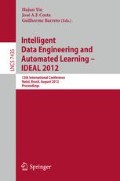Abstract
In this work Discrete Fourier Transform (DFT) and Discrete Wavelet Transform (DWT) were experimentally evaluated for their performances as tools for dimensionality reduction in a real data set of air traffic trajectories. Results showed that both DFT and DWT were able to provide very expressive reduction for trajectory representation with minimal loss of information. Overall, DWT performed slightly better requiring fewer coefficients than DFT to achieve the same signal energy or to provide the same quality of reconstruction of the trajectories.
Access this chapter
Tax calculation will be finalised at checkout
Purchases are for personal use only
Preview
Unable to display preview. Download preview PDF.
References
Piciarelli, C., Foresti, G., Snidaro, L.: Trajectory clustering and its applications for video surveillance. In: IEEE Conf. Advanced Video and Signal Based Surveillance, pp. 40–45. IEEE Computer Society, Los Alamitos (2005)
Kim, H.-S., Kim, J.-H., Ho, C.-H., Chu, P.-S.: Pattern classification of typhoon tracks using the fuzzy c-means clustering method. Journal of Climate 24(2), 488–508 (2011)
Spampinato, C., Giordano, D., Di Salvo, R., Chen-Burger, Y.-H.J., Fisher, R.B., Nadarajan, G.: Automatic fish classification for underwater species behavior understanding. In: Proc. First ACM Int. Workshop on Analysis and Retrieval of Tracked Events and Motion in Imagery Streams, ARTEMIS 2010, pp. 45–50. ACM, New York (2010)
Lee, J.W., Paek, O.H., Ryu, K.H.: Temporal moving pattern mining for location-based service. Journal of Systems and Software 73(3), 481–490 (2004)
Melo, J., Naftel, A., Bernardino, A., Santos-Victor, J.: Detection and classification of highway lanes using vehicle motion trajectories. IEEE Trans. Intelligent Transportation Systems 7(2), 188–200 (2006)
Knorr, E.M., Ng, R.T., Tukanov, V.: Distance-based outliers: algorithms and applications. VLDB Journal 8(3), 237–253 (2000)
Lee, J.G., Han, J., Whang, K.Y.: Trajectory clustering: a partition-and-group framework. In: Proc. 2007 ACM SIGMOD Int. Conf. Management of Data, pp. 593–604 (2007)
Gariel, M., Srivastava, A.N., Feron, E.: Trajectory Clustering and an Application to Airspace Monitoring. IEEE Trans. Intelligent Transportation Systems 12(4), 1511–1524 (2011)
Eckstein, A.: Automated flight track taxonomy for measuring benefits from performance based navigation. In: Integrated Communications, Navigation and Surveillance Conference (2009)
Naftel, A., Khalid, S.: Motion Trajectory Learning in the DFT-Coefficient Feature Space. In: Proc. IEEE Int. Conf. Computer Vision Systems (2006)
Kaplan, W.: Advanced Calculus. Addison-Wesley (1971)
Oppenheim, A.V., Schafer, R.W.: Discrete-Time Signal Processing. Pretice-Hall (1989)
Burrus, C.S., Gopinath, R.A., Guo, H.: Introduction to Wavelets and Wavelet Transform: A Primer. Prentice-Hall (1998)
Mallat, S.G.: A Theory for Multiresolution Signal Decomposition: The Wavelet Representation. IEEE Trans. Pattern Analysis and Machine Learning 11(7), 674–693 (1989)
R Development Core Team: R: A language and environment for statistical computing. R Foundation for Statistical Computing, Vienna, Austria (2011) ISBN 3-900051-07-0, http://www.R-project.org/
Nason, G.: wavethresh: Wavelets statistics and transforms. R package version 4.5. (2010), http://CRAN.R-project.org/package=wavethresh
Author information
Authors and Affiliations
Editor information
Editors and Affiliations
Rights and permissions
Copyright information
© 2012 Springer-Verlag Berlin Heidelberg
About this paper
Cite this paper
Annoni, R., Forster, C.H.Q. (2012). Experimental Comparison of DWT and DFT for Trajectory Representation. In: Yin, H., Costa, J.A.F., Barreto, G. (eds) Intelligent Data Engineering and Automated Learning - IDEAL 2012. IDEAL 2012. Lecture Notes in Computer Science, vol 7435. Springer, Berlin, Heidelberg. https://doi.org/10.1007/978-3-642-32639-4_80
Download citation
DOI: https://doi.org/10.1007/978-3-642-32639-4_80
Publisher Name: Springer, Berlin, Heidelberg
Print ISBN: 978-3-642-32638-7
Online ISBN: 978-3-642-32639-4
eBook Packages: Computer ScienceComputer Science (R0)

